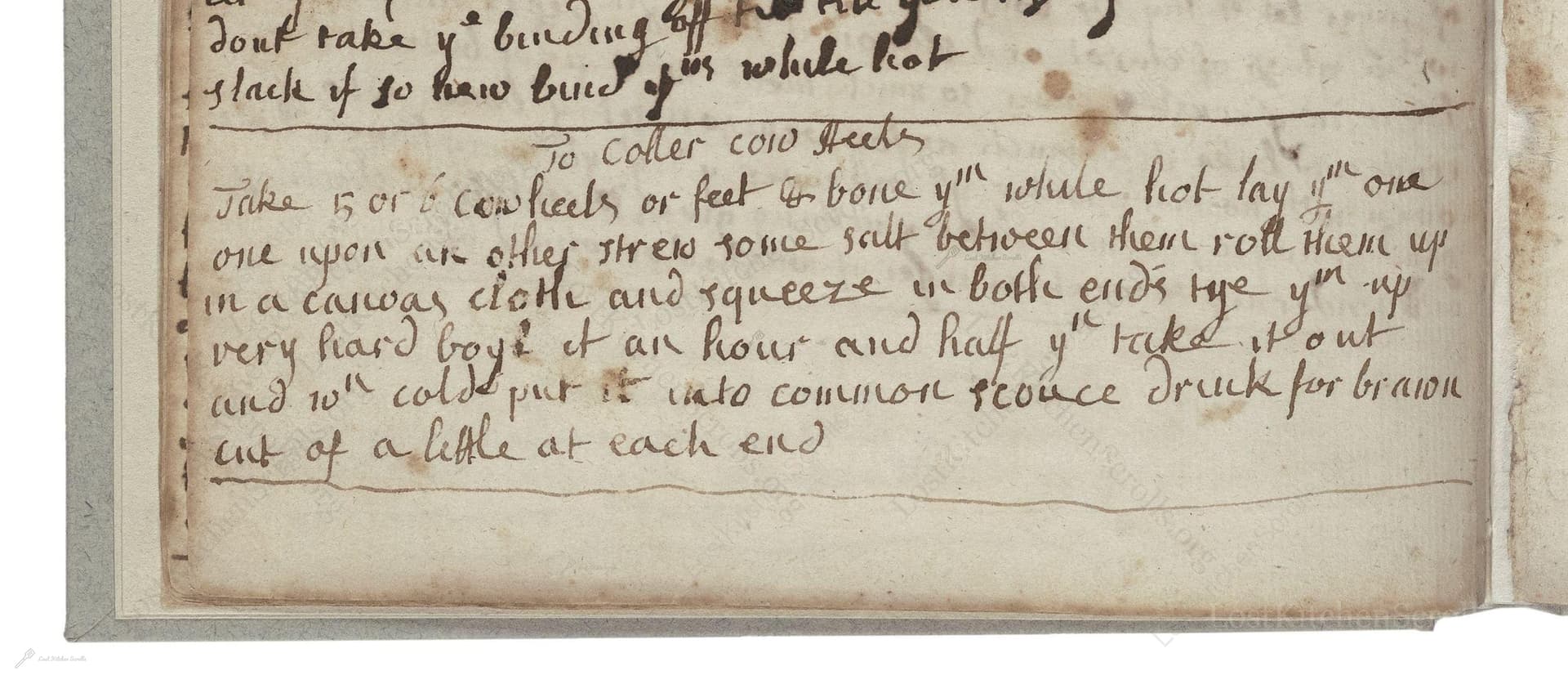To Coller Cow Heeles
From the treasured pages of Mrs. Knight's receipt book
Written by Mrs. Knight

To Coller Cow Heeles
"Take 5 or 6 cow heels or feet & bone ym one upon an other strew some salt between them roll them up in a canvas cloth and squeeze in both ends tye ym up very hard boyle it an hour and half and wn cold put it into common sounce drunk for braion cut out of a little at each end."
Note on the Original Text
The recipe is written in period English, featuring archaic spellings ('colller' for 'collar', 'heeles' for 'heels', 'ye' or 'ym' as forms of 'them'), and it is brief—assuming the reader is already familiar with basic kitchen processes and tools. Instructions are direct and practical, omitting precise measurements and assuming a level of practical kitchen knowledge. Spelling in recipes of this era was largely phonetic and not yet standardized, which is reflected in the original text.

Title
Mrs. Knight's receipt book (1740)
You can also click the book image above to peruse the original tome
Writer
Mrs. Knight
Era
1740
Publisher
Unknown
Background
Step into the refined kitchens of 18th-century England with Mrs. Knight’s culinary collection, where time-honored recipes, hearty roasts, and elegant pastries await the enterprising cook.
Kindly made available by
Folger Shakespeare Library
This recipe dates to around 1740 and comes from Mrs. Knight, a woman active in England during that period. Cow heels were an affordable and hearty cut, rich in gelatin and ideal for preservation—a necessity before modern refrigeration. This dish would have been both practical and nourishing, often served cold in slices or as a pickled souse, reflecting the British penchant for thrifty, nose-to-tail cooking. The use of boiling and salting was essential both for food safety and for transforming tough, collagen-rich cuts into a delicacy fit for everyday tables or even as a simple celebration treat.

Historically, the cook would have used a sharp boning knife to remove the tough bones from the cow's feet, and a length of stout cloth—commonly linen or canvas—to wrap the meat. String or twine was essential to hold the bundle tightly together. The cooking would take place in a large iron or copper cauldron suspended over an open hearth or set into a stove; steady simmering was key. Once cooled, slices would be cut with a large knife and served on earthenware or pewter plates.
Prep Time
45 mins
Cook Time
1 hr 30 mins
Servings
10
We've done our best to adapt this historical recipe for modern kitchens, but some details may still need refinement. We warmly welcome feedback from fellow cooks and culinary historians — your insights support the entire community!
Ingredients
- 5-6 cow's heels (or substitute with pig's feet, if unavailable), approximately 7½–9 lbs
- Coarse kosher salt, about 1½–2 oz (roughly 1–2 tablespoons per layer)
- Muslin or cheesecloth, for rolling
- Kitchen string or butcher's twine
Instructions
- Begin with 5 or 6 cow's heels (also known as cow's feet), which you can ask for at a good butcher.
- Carefully remove the bones from each foot, then stack the boned feet one on top of another, sprinkling salt between each layer.
- Once all the feet are stacked and salted, roll them up tightly inside a sturdy muslin or cheesecloth.
- Twist both ends firmly and tie them securely with kitchen string to maintain the shape.
- Place your wrapped roll in a large pot of simmering water, ensuring it is fully submerged.
- Boil gently for about 1½ hours.
- Once cooked, remove the roll from the water and let it cool completely, keeping it wrapped to retain the shape.
- Once cold, carefully unroll and slice pieces from each end to serve.
- Optionally, serve in a modern souse (pickle) or braise as preferred.
Estimated Calories
300 per serving
Cooking Estimates
The total time includes prepping the cow's heels or pig's feet, removing the bones, salting, rolling in muslin, and boiling for 1.5 hours. You’ll need about 45 minutes to prepare everything and 1.5 hours to cook. Each serving is around 300 calories, and the recipe makes 10 servings.
As noted above, we have made our best effort to translate and adapt this historical recipe for modern kitchens, taking into account ingredients nowadays, cooking techniques, measurements, and so on. However, historical recipes often contain assumptions that require interpretation.
We'd love for anyone to help improve these adaptations. Community contributions are highly welcome. If you have suggestions, corrections, or cooking tips based on your experience with this recipe, please share them below.
Join the Discussion
Rate This Recipe
Dietary Preference
Main Ingredients
Culinary Technique
Occasions

Den Bockfisch In Einer Fleisch Suppen Zu Kochen
This recipe hails from a German manuscript cookbook compiled in 1696, a time whe...

Die Grieß Nudlen Zumachen
This recipe comes from a rather mysterious manuscript cookbook, penned anonymous...

Ein Boudain
This recipe comes from an anonymous German-language manuscript cookbook from 169...

Ein Gesaltzen Citroni
This recipe, dating from 1696, comes from an extensive anonymous German cookbook...
Browse our complete collection of time-honored recipes



